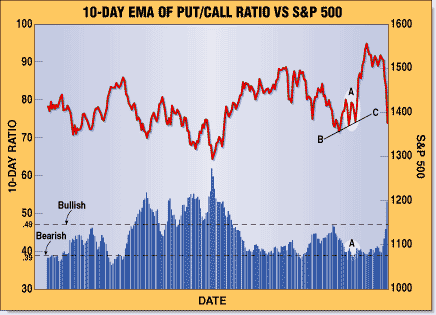OPTIONS
A Put/Call Ratio Oscillator To Pinpoint Market Conditions
by John Summa
Who says the put/call ratio doesn't work anymore? Here's an oscillator that's great for pinpointing intermediate market tops and bottoms.
What's the ideal time to write an option? The ideal time to write a deep out-of-the-money (DOTM) put or call options credit spread? While charts may tell you when to exit such a position, the correct use of put/call ratios offer an excellent way of determining just when to enter your trade. Here's one approach to interpreting equity-only put/call ratios, combined with my own volume-weighted, put/call ratio oscillator for finding just when to write your DOTM spreads for maximum probability of success.

FIGURE 1: PUT/CALL RATIO. An exponential moving average of the raw put/call ratio does a tolerable job of pinpointing short-term lows in the S&P 500.
During any intermediate bull or bear trend, investor moods tend to remain slanted in one direction or the other -- hopeful or worried, driven by greed on one hand and fear on the other. When either sentiment becomes too prevalent, contrarian analysis suggests that the trend is ready for a change. This is based on the view long held by technicians that the majority of the investing public is usually wrong just when everything seems right. Historical data confirms that it is indeed possible to construct parameters that indicate when the crowd has gone too far toward one extreme or the other, where conditions are thus ripe for a reversal.
Market professionals and insiders, therefore, often attempt to trade crowd psychology in the opposite direction, often referred to as contrarian technical analysis. Indeed, put/call ratios have been, and remain, very effective contrarian sentiment tools, particularly since the public's speculative use of options has exploded with the online investing revolution.
However, using contrarian sentiment -- put/call ratios -- as a trading signal is not necessarily a good idea. While put/call ratios can tell what the overall market mood is, these sentiment indicators don't tell you when to trade. While conventional use of put/call ratios can be useful, often it is difficult to know just when excessive bearishness or bullishness has become too much in terms of making a trading decision.
Determining overbought and oversold market conditions for making trades can be tricky with any indicator, as overbought or oversold conditions can persist for longer than your indicators suggest, leaving you flattened by another bull stampede or bear attack -- a problem that traders are familiar with all too well.
John Summa is a commodity trading advisor and operates his own options trading advisory service, OptionsNerd.com (https://www.optionsnerd.com). In partnership with Traders' Edge, he is offering options on futures trade recommendations free to all traders who register at his Website.
Excerpted from an article originally published in the August 2000 issue of Technical Analysis of STOCKS & COMMODITIES magazine. All rights reserved. © Copyright 2000, Technical Analysis, Inc.
Return to August 2000 Contents